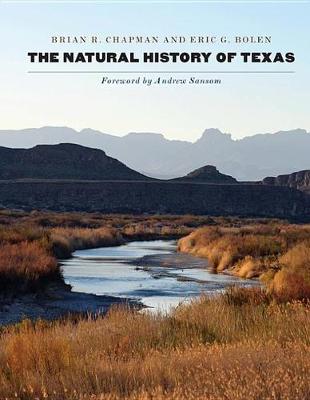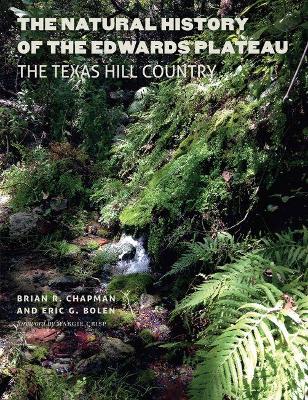Integrative Natural History
3 total works
The Natural History of the Trans-Pecos
by Brian R. Chapman and Eric G. Bolen
Published 30 November 2020
The last frontier in Texas, the Trans-Pecos region is an immense and remote series of desert basins in the western-most part of the state. Columns of rock and stony debris dot the landscape, with various peaks, such as the notable El Capitan, rising from a long-forgotten sea floor. While the acidic and shallow desert soil only allows for scrubby vegetation in many places, what survives is rugged, colorful, and adaptable. Far from just an arid region, however, the Trans-Pecos is also home to grasslands, wetlands, and even woodlands. Animal life varies considerably, from the Black-tailed Jackrabbit and Desert Cicada to Bighorn Sheep, Black Bears, and Mountain Lions.
Complete with an introduction chronicling the stories of biologists and naturalists who have explored and defined the ecological areas of Texas over time, The Natural History of the Trans-Pecos explores the formation of the region more than 600 million years ago, the adaptability of its ecosystems, and the conservation efforts to keep these wildly diverse environments flourishing. Detailed descriptions, vivid anecdotes, and vibrant pictures of the features that make this region so unique emphasize the rugged grandeur of the Trans-Pecos.
Complete with an introduction chronicling the stories of biologists and naturalists who have explored and defined the ecological areas of Texas over time, The Natural History of the Trans-Pecos explores the formation of the region more than 600 million years ago, the adaptability of its ecosystems, and the conservation efforts to keep these wildly diverse environments flourishing. Detailed descriptions, vivid anecdotes, and vibrant pictures of the features that make this region so unique emphasize the rugged grandeur of the Trans-Pecos.
From two veteran ecologists comes a new and sweeping exploration of the natural history of Texas in all its biological diversity and geological variation. Few states, if any, can match Texas for its myriad species, past and present, and its many distinctive landscapes, from prairie grasslands and hardwood forests to coastal lagoons and desert mountains.
Beginning with the stories of how biologists and naturalists have over time defined the ecological areas of this very big state, the authors visit each of the eleven regions, including the Texas coast. They describe the dominant flora and fauna of each, explain the defining geologic features, and highlight each region's unique characteristics, such as carnivorous plants in the Piney Woods and returning black bears in the Trans-Pecos.
Throughout, the authors remain especially conscious of the conservation and management issues affecting the natural resources of each region, revealing their deep affection for and knowledge about the state. Bolstered by a glossary, further reading suggestions, a description of state symbols, and an appendix of scientific names, this is an educational and essential volume for all Texans.
Beginning with the stories of how biologists and naturalists have over time defined the ecological areas of this very big state, the authors visit each of the eleven regions, including the Texas coast. They describe the dominant flora and fauna of each, explain the defining geologic features, and highlight each region's unique characteristics, such as carnivorous plants in the Piney Woods and returning black bears in the Trans-Pecos.
Throughout, the authors remain especially conscious of the conservation and management issues affecting the natural resources of each region, revealing their deep affection for and knowledge about the state. Bolstered by a glossary, further reading suggestions, a description of state symbols, and an appendix of scientific names, this is an educational and essential volume for all Texans.
The Natural History of the Edwards Plateau
by Brian R. Chapman and Eric G. Bolen
Published 30 November 2020
The roughly 24 million acres of that make up the Edwards Plateau, commonly known as the Texas Hill Country, are characterized by rolling highlands, picturesque river canyons, and beautiful springtime wildflowers. Located in the heart of Texas, this region is home to hundreds of natural springs, thousands of limestone caves, and the famous Devil's Sinkhole. Encompassing grasslands, savannas, and woodlands, the Edwards Plateau is a unique and diverse ecological haven.
Beginning with the stories of how biologists and naturalists have defined the ecological areas of the great state of Texas over time, The Natural History of the Edwards Plateau explores the formation of the region more than a billion years ago, its diverse ecosystems, and the conservation efforts to keep those ecosystems intact and thriving. With detailed descriptions and vivid pictures of the flora, fauna, and geologic features that make this area so unique, the authors also explore the ways in which people have interacted with the ecosystems over time, from natural spring water used by San Antonio's Pearl Brewing Company to the use of bats for gunpowder and bombing raids.
In their exploration of the natural history, veteran ecologists Brian R. Chapman and Eric G. Bolen remain especially conscious of the conservation and management issues that affect the natural resources of the Edwards Plateau region, revealing their deep connection to the state. Bolstered by a glossary, further reading suggestions, and an appendix of scientific terms, this is an educational and essential guide for all Texans and environmental enthusiasts.
Beginning with the stories of how biologists and naturalists have defined the ecological areas of the great state of Texas over time, The Natural History of the Edwards Plateau explores the formation of the region more than a billion years ago, its diverse ecosystems, and the conservation efforts to keep those ecosystems intact and thriving. With detailed descriptions and vivid pictures of the flora, fauna, and geologic features that make this area so unique, the authors also explore the ways in which people have interacted with the ecosystems over time, from natural spring water used by San Antonio's Pearl Brewing Company to the use of bats for gunpowder and bombing raids.
In their exploration of the natural history, veteran ecologists Brian R. Chapman and Eric G. Bolen remain especially conscious of the conservation and management issues that affect the natural resources of the Edwards Plateau region, revealing their deep connection to the state. Bolstered by a glossary, further reading suggestions, and an appendix of scientific terms, this is an educational and essential guide for all Texans and environmental enthusiasts.


